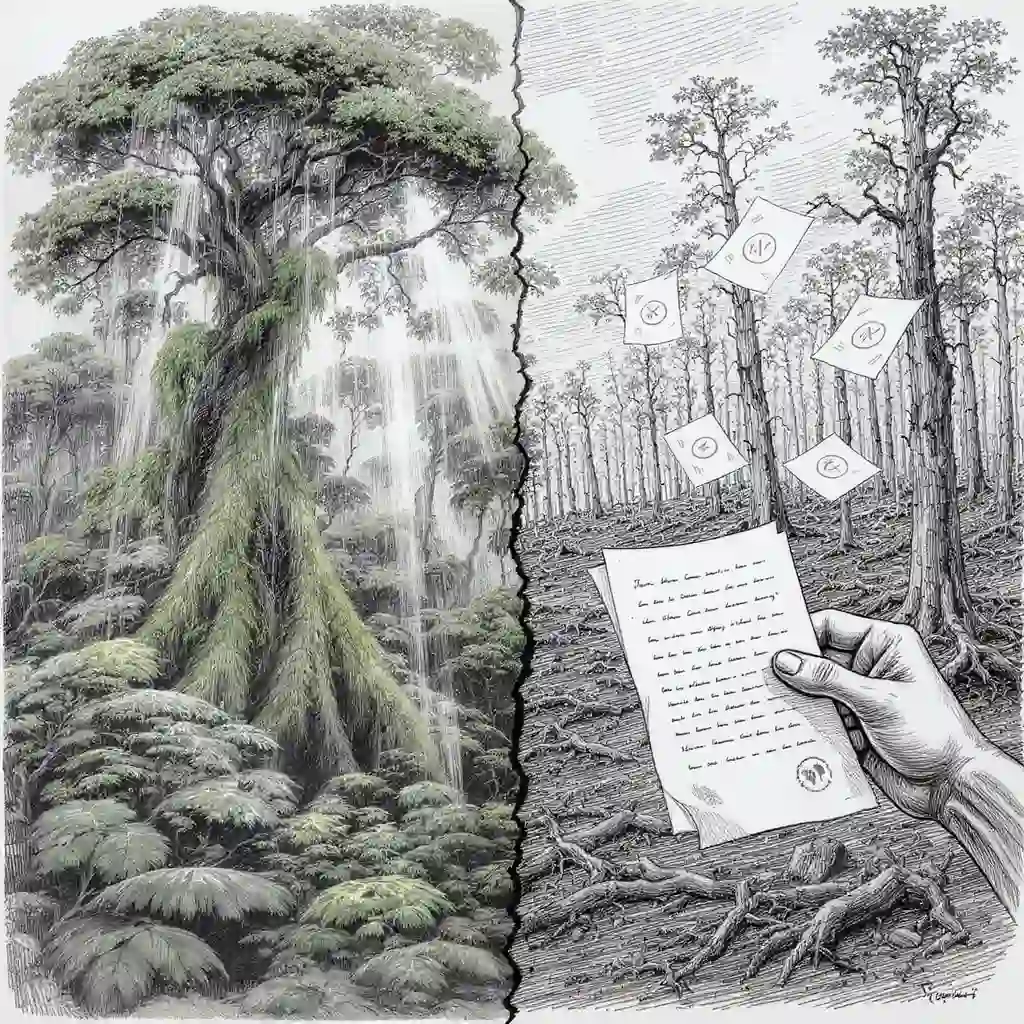Why Carbon Credits Won't Save the Amazon How REDD+ Projects Actually Fail

Imagine the scenario.
A big company — a bank, manufacturer, tech giant — releases a press statement saying it achieved carbon neutrality.
How? It bought carbon credits. Say ten thousand credits from a REDD+ project in Peru means ten thousand tons of CO2 didn't enter the atmosphere.
Sounds fair. Honest. Responsible.
One problem. Money goes to supposedly prevent deforestation that wouldn't happen anyway. And the forest next door keeps getting chopped down.
But there's another side to this story — people who say REDD+ works and the numbers are real. Let's figure out who's right.
How Carbon Credits Became a Reputation Laundering Tool
REDD+ (Reduced Emissions from Deforestation and forest Degradation) sounds simple even noble. Wealthy countries and companies pay developing countries so they don't cut down forest. Money for conservation. Sounds like win-win.
Over twenty years this idea attracted billions. In 2024 alone over a billion tons of CO2 moved through voluntary carbon markets as credits. The whole system rests on one assumption that people believe these credits reflect real emission reductions.
Most of them don't.
Premium Carbon Integrity
Peru's Amazon carbon credits achieve premium integrity standards through REDD+ and ARR methodologies by 2035
Explore Standards300% ROI Green Gold
Peru's REDD+ investments showcase Amazon's green gold potential with projected returns exceeding 300% by 2035
View Returns500% VC Returns
Unlock 7 jungle investment secrets that venture capitalists use to achieve 500% returns in emerging markets
Discover SecretsSUNARP Legal Guide
Critical 2025-2026 Peru jungle land investment rules - how foreign investors navigate SUNARP requirements
Legal DetailsWhat the Critics Are Saying
A study from the University of Pennsylvania in 2025 analyzed 95 carbon projects previously flagged as overvalued. Finding shocked everyone. Two-thirds of auditors who were supposed to catch errors missed them. This isn't accident. It's proof the entire audit system doesn't work.
In October 2024 the U.S. Department of Justice charged CQC Impact Investors one of the biggest carbon project developers with fraud. The company systematically faked data to create six million phantom credits. The fraud added up to two hundred fifty million dollars.
This wasn't one case. In March 2025 Corporate Accountability published a report showing 47.5 million carbon credits from 43 largest projects were overvalued. That means almost half of all credits exported to market are basically air.
What the Supporters Are Saying
Yet many project developers and international organizations claim REDD+ saves millions of hectares. That the system while imperfect is still better than nothing. That the criticized projects are exceptions not the rule. That reforms are happening and quality is improving.
Question is who do you believe. And here's where it gets interesting.
Why REDD+ Doesn't Work in the Amazon A Practical Look
The whole system rests on math that looks like predicting the future. A project starts in a forest district in Peru. Analysts say in this district historically they lose a thousand hectares of forest per year. If we put money here deforestation drops to five hundred hectares. So we saved five hundred hectares per year.
Beautiful logic. On paper.
First Problem Shifting Benefits
What actually happens. The Brazilian government launches a national anti-deforestation program. The whole Amazon including the district where the REDD+ project operates drops in deforestation. But the project still demands its credits for saving forest. Except the saving happened because of government action not their money. The REDD+ project just parasites on someone else's success.
Second Problem Leakage
Loggers and gold miners just move to the next district over. The REDD+ project protected one zone but deforestation just shifted. Researchers call this leakage. The carbon credits went somewhere but CO2 in the atmosphere stayed put.
Third Problem Land Rights
A REDD+ project only works if the people living on that land agree. But in Peru often they don't or the agreement is fake. Result the project stalls and corrupt officials take bribes to ignore it.
That's why a PNAS study from 2020 showed that in half of REDD+ projects deforestation was higher than in control areas.
The Auditors Who Were Supposed to Find Truth But Didn't
Carbon credit system rests on three assumptions.
First that projects honestly count trees. Second that auditors honestly check the numbers. Third that the market trusts both sides.
All three are breaking.
Conflict of Interest in Auditing
A University of Pennsylvania study in 2025 showed that independent auditors often aren't independent. The same project developers who they're supposed to audit hire them. If an auditor finds problems the project won't hire them next time. If an auditor stays quiet the work keeps coming.
Scale of Overvaluation
In March 2025 Corporate Accountability reported that 47.5 million carbon credits from 43 biggest projects were overvalued. Almost half of all credits exported to market are basically air.
Verra the biggest registry of voluntary carbon credits on the planet refused to implement proposed reforms. The company said moving audits to independent financing would be complicated and expensive. Translation we know there's a problem but it's more profitable to leave it alone.
Peru As a Case Study of REDD+ Failure at National Level
Peru is one of the most active REDD+ experimenters. The country and indigenous groups signed contracts with several international project developers. On paper everything should have worked.
In practice deforestation in Peru keeps rising. Especially in border districts with Brazil where government control doesn't exist. REDD+ projects in these zones just don't work.
Why This Happens
Because a REDD+ project can't solve corruption problems lack of land rights and general government weakness. REDD+ can only add money. But if money goes into the pockets of officials who then sell land to loggers the system becomes a tool for stealing resources not saving them.
Peru's Indigenous-led REDD+ Story
Peru even ran the world's first Indigenous-led jurisdictional REDD+. On paper this meant indigenous peoples controlled the carbon credits and the income. In reality they got a tiny piece of profit and big money went to international consultants.
What This Means for Companies Buying Carbon Credits
See a press release from a company claiming carbon neutrality. Probably they bought credits that might be phantom.
This doesn't mean the company is lying on purpose. Usually they hire consultants who tell them everything's fine. But those consultants use data that might be fake. Every link in the chain rests on trust. And trust is broken.
What Companies Should Actually Do
Companies that genuinely want to cut emissions need to do three things.
First invest in their own technology and processes to cut emissions directly. Carbon credits aren't a replacement for that just an add-on.
Second buy credits only from highly integrated and verifiable sources. Like Guyana TREES which uses satellite data and direct government payments.
Third don't believe numbers on faith verify them independently.
Two Sides of the Story What to Pick
The Optimistic Take
Maybe critics are too dark. Maybe reforms really are happening. Maybe Verra 2.0 standards really are better. Maybe SEC and FTC regulation really will clean up the market. Maybe some percentage of credits actually has real impact. Even if it's not 100% but 40% that's still something.
Some people believe in REDD+ because they see it as the best tool available right now. They point to projects where deforestation really did drop. They say skeptics ignore the good projects only focus on the bad ones.
The Pessimistic Take
Or maybe the system is rotten from foundation up. Maybe when big money is involved honesty comes second. Maybe reforms will take forever because interested parties push back. Maybe by 2035 the Amazon loses another 10% of forest despite all the carbon credits. Maybe companies announcing neutrality now are just greenwashing.
Some people don't believe REDD+ because they've watched too many beautiful promises turn to nothing. They see the pattern money flows corruption follows and forests disappear anyway.
Here's the real question based on everything you know about how big financial systems work what seems more likely.
Future of REDD+ Will the System Collapse
The system won't completely collapse because too much money is tied up. Companies creating carbon credits project developers consultants — they all benefit if the system keeps working even if it doesn't actually work.
But the system is degrading. DOJ criminal cases FTC penalties SEC new disclosure rules — it all increases pressure. By 2026 expect tougher standards and less fraud. But also less legitimate capital because investors are getting disappointed.
What This Means for the Amazon
For the Amazon this means carbon credits will never be the main tool for saving it. Forest survives through national law enforcement of land rights and recognition of indigenous peoples. Carbon credits might help around the edges but they're not the solution.
Final Word Don't Believe Anyone Blindly
Company says it's carbon neutral. Ask where the credits came from. If the answer is vague that's a red flag. Company says it invests in REDD+. Ask which specific project and why that one. If the answer is full of buzzwords that's another red flag.
Remember the Amazon doesn't get saved by money. It gets saved by law enforcement and political will. Everything else including carbon credits is just pretty promises that let wealthy nations and corporations sleep better at night.
Sources
-
PNAS (Proceedings of the National Academy of Sciences) — Overstated carbon emission reductions from voluntary REDD+ projects (2020) — https://pnas.org/
-
Mongabay — REDD+ carbon and deforestation cuts in Amazon overestimated (2021) — https://news.mongabay.com/
-
Mongabay — Independent auditors overvalue credits of carbon projects study finds (2025) — https://news.mongabay.com/
-
Corporate Accountability — Carbon Credits Overvaluation Report (2025)
-
University of Pennsylvania Law School — Climate and Carbon Litigation Trends (2025) — https://corpgov.law.harvard.edu/
-
DOJ (U.S. Department of Justice) — CQC Impact Investors Carbon Credit Fraud Case (2024)
-
Oregon State University — Analysis of the effectiveness efficiency and co-benefits of REDD+ in Peru — https://ir.library.oregonstate.edu/
-
UN-REDD Programme — 2024 Annual Report (2024) — https://mptf.undp.org/
-
Architecture for REDD+ Transactions (ART) — Winter 2025 Newsletter (2025) — https://artredd.org/
-
Wiley Online Library — REDD+ and forest protection on indigenous lands in the Amazon — https://onlinelibrary.wiley.com/
-
Winrock International — ACR presents annual Carbon Market Awards (2025) — https://winrock.org/
